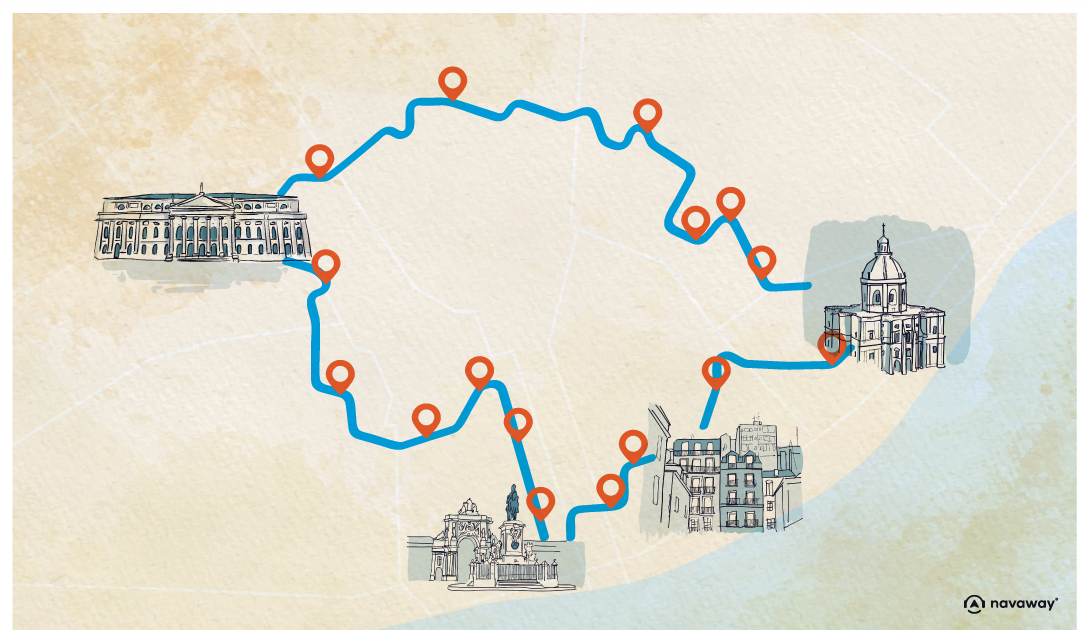
Visit Óbidos: Portugal’s charming medieval town
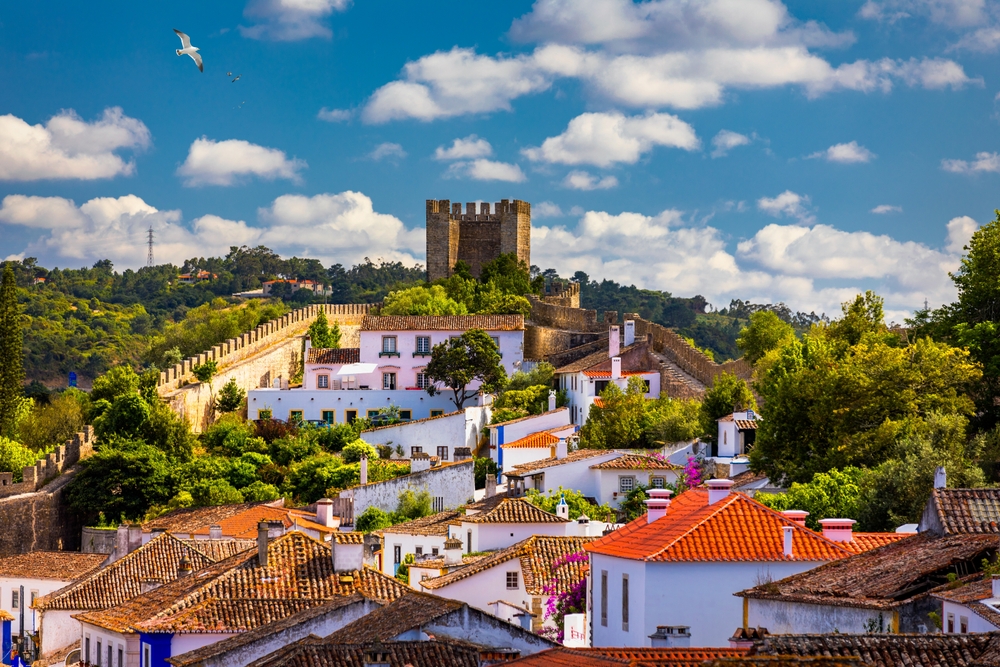
Perched on a hill in central Portugal, the medieval city of Óbidos is a real architectural gem, fascinating visitors with its perfectly preserved ramparts, cobbled streets and period atmosphere. Nicknamed “the city of queens” ever since King Denis I presented it to his wife Isabella in 1282, this historic gem just 80 kilometres from Lisbon is a must for anyone wishing to discover the authentic soul of medieval Portugal.

This ancient fortress, surrounded by imposing walls, offers a total immersion in Portuguese history. With its royal castle, churches steeped in history, ginja tastings in chocolate cups and colourful festivals, Óbidos promises a unique experience where every stone tells the story of a part of the Lusitanian epic.
Read also about the Portugal guide :
- Weekend in Lisbon: visit Lisbon in 2, 3 or 4 days
- Visit Porto in 1 day: 27 things to do and see on foot
- What to do in Lisbon Top 10 activities + Good tips
- Visit Coimbra in 1 day: 25 things to do and see on foot
- Visit Aveiro in 1 day: 18 things to do and see on foot
1. Discover Óbidos Castle and its majestic ramparts
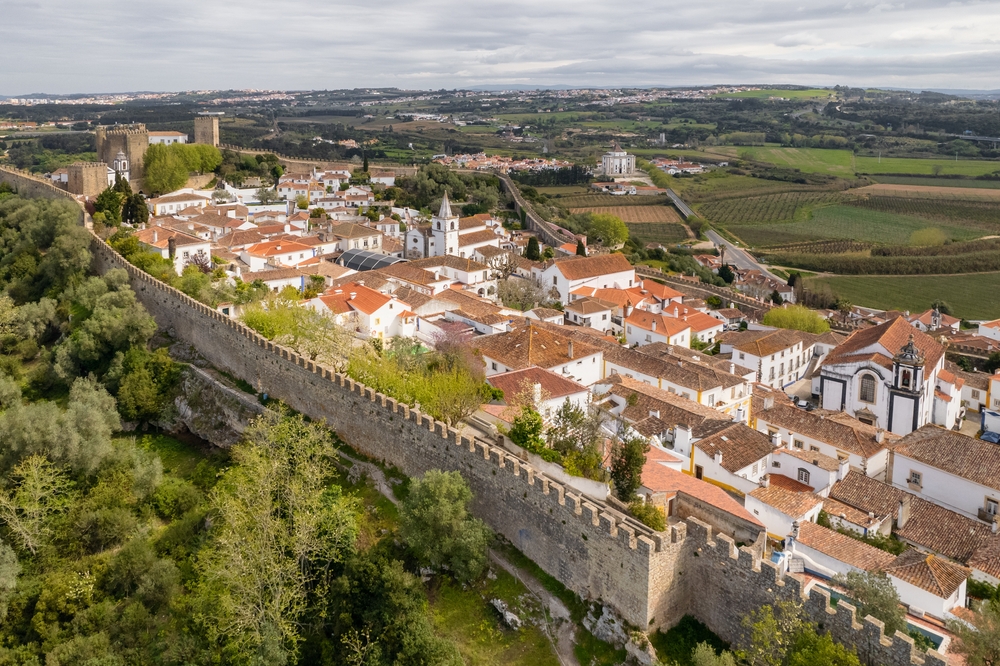
Óbidos Castle, built in the 12th century and reinforced by King Denis I, is the beating heart of the medieval town. This imposing fortress, listed as a National Monument, proudly dominates the surrounding plain and offers exceptional panoramic views over the region. Today transformed into a luxury hotel (Pousada Castelo de Óbidos), it remains one of the most emblematic symbols of medieval Portugal.
The walls of Óbidos stretch for almost 1.5 kilometres and can be explored in their entirety on foot. This walk along the walls, accessible from several points in the village, is one of the most memorable experiences of the visit. Visitors will discover unique views of the red-tiled roofs, secret gardens and rolling countryside around them. A walk along the ramparts will give you an insight into the defensive ingenuity of this medieval stronghold, while taking in breathtaking panoramic views.
2. Explore the Porta da Vila and its exceptional azulejos
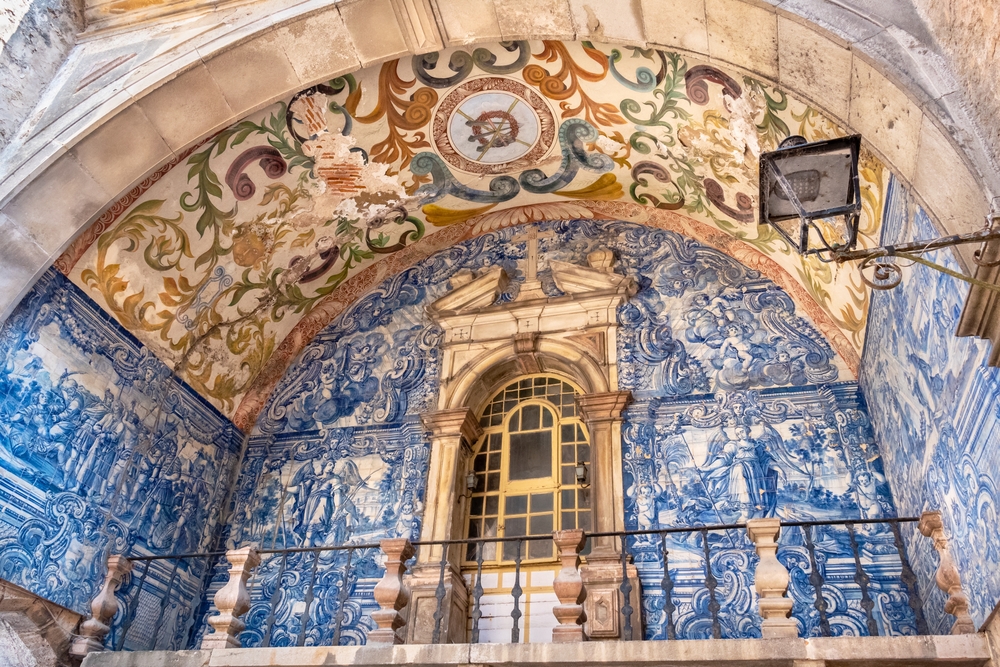
The main entrance to Óbidos, the Porta da Vila, built in 1380, is a true artistic masterpiece. This fortified gateway houses a Baroque chapel adorned with magnificent 18th-century blue azulejos, finely depicting the Passion of Christ. These hand-painted ceramic tiles bear witness to Portuguese artistic refinement and create a striking transition between the exterior and the hushed world of the medieval city.
As soon as they pass through this emblematic gateway, visitors are transported to another time. The architecture of the Porta da Vila harmoniously blends Moorish and Christian influences, reflecting Portugal’s rich culture. This is also where the Óbidos experience really begins, with the first shops selling the famous ginja served in chocolate cups.
3. Stroll along Rua Direita, the village’s historic thoroughfare
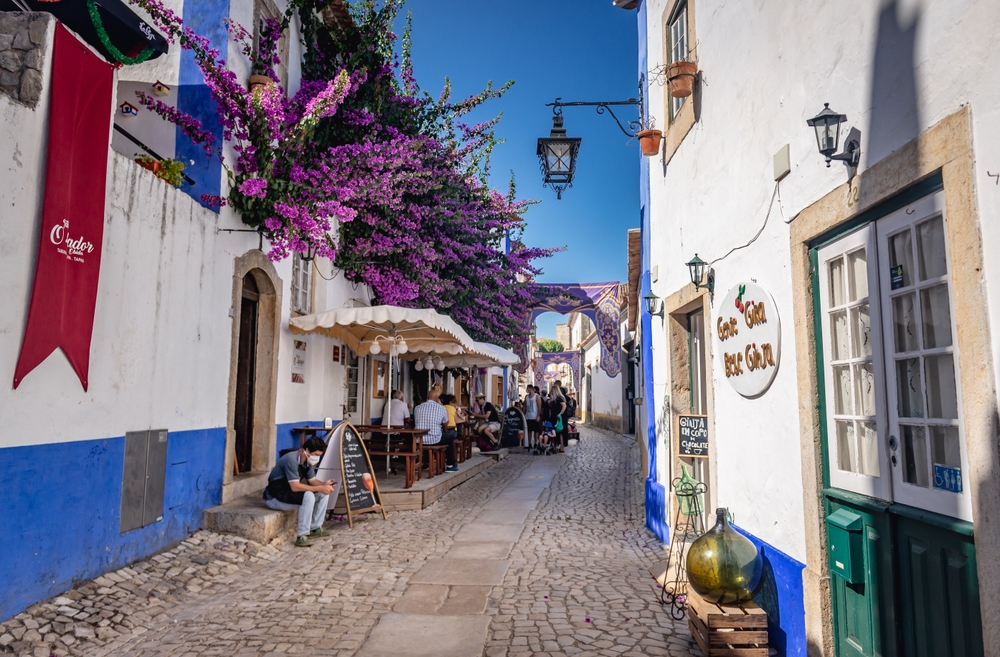
The Rua Direita is Óbidos’ main thoroughfare, running for around 300 metres from the Porta da Vila to the castle. This cobbled street, lined with white houses with their characteristic blue and yellow outlines, concentrates most of the village’s commercial and craft activity. The colourful facades, adorned with flower-filled balconies and meticulous architectural detailing, create a picturesque atmosphere that enchants visitors.
This historic thoroughfare is lined with local craft shops, art galleries, specialist bookshops and stalls selling regional produce and authentic souvenirs. Rua Direita is also a popular venue for the many events held in Óbidos, including the famous summer medieval festival, which transforms the street into a living medieval stage.
4. Visit the church of Santa Maria, witness to royal splendour
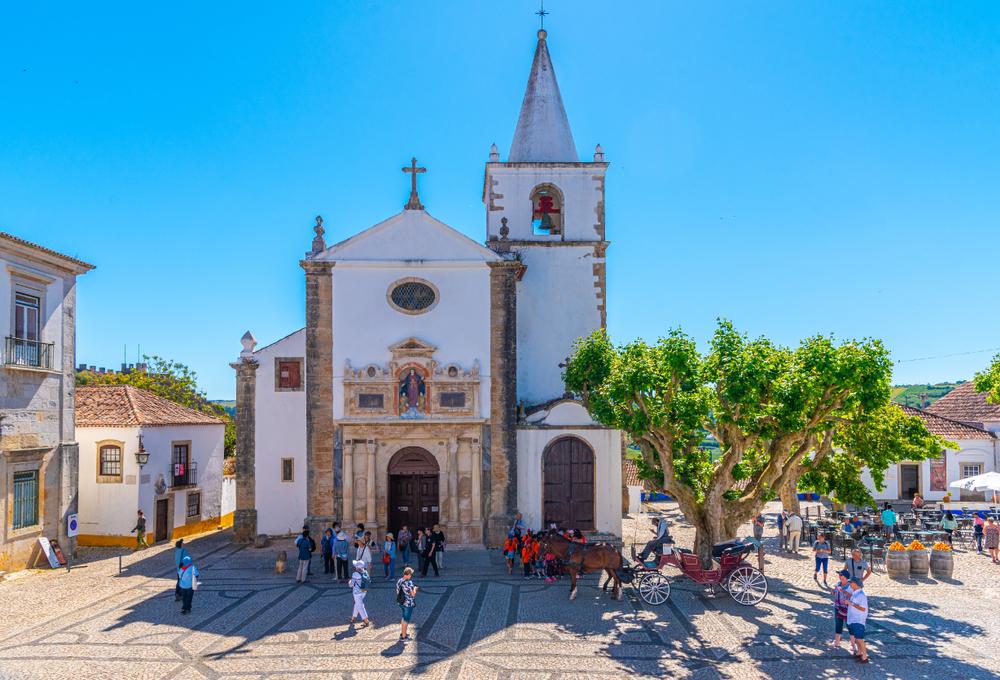
Thechurch of Santa Maria, located in the main square of Óbidos, occupies a special place in Portuguese history. Rebuilt in the 16th century in Renaissance style, it stands on the foundations of an ancient Visigoth temple that was transformed into a mosque and then a Christian sanctuary in the 12th century. This historical stratification makes the building a unique testimony to the religious and cultural evolution of the region.
The church owes its fame to the wedding celebrated within its walls in 1441 between King Alfonso V and Joan of Portugal, who were only 10 years old at the time. The richly decorated Baroque interior houses remarkable works of art and precious azulejos. Its white bell tower, visible from afar, rises majestically above the rooftops of the village and is an indispensable landmark for anyone visiting Lisbon and wishing to discover the treasures of the surrounding area.
5. Discover the Municipal Museum and the art of Josefa de Óbidos
The Óbidos Municipal Museum, housed in an elegant 18th-century manor house adjacent to the Santa Maria church, boasts a remarkable collection of sacred art spanning several centuries. The institution gives particular pride of place to the works of Josefa de Óbidos (1630-1684), Portugal’s only known female painter of the 17th century, whose Baroque canvases bear witness to an exceptional talent.
The museum’s collections trace the artistic and religious development of the region since the Middle Ages, with pieces of gold and silverware, polychrome sculptures and paintings by Portuguese masters. This cultural visit is the perfect complement to an architectural tour of the city, and provides a deeper understanding of local history. The museum is a must for lovers of Baroque art and religious history.
6. Enjoy Óbidos Ginja in a chocolate cup
Ginja d’Óbidos is one of the most emblematic tasting experiences of the visit. This tart cherry liqueur, produced locally according to a traditional recipe dating back to the monks of the 17th century, is served in an edible dark chocolate cup. This original presentation, which has become the city’s signature, transforms the tasting experience into a veritable gourmet ritual.
Several establishments in the village offer this speciality, notably near Porta da Vila. The liqueur, which contains around 20% alcohol, develops complex sweet and sour cherry aromas that are perfectly balanced by the sweetness of the chocolate. This unique culinary tradition is a perfect illustration of the Portuguese art of living and the local creativity in combining flavours. Ginja tasting is an unmissable convivial moment that enriches the experience of discovering Óbidos.
7. Taking part in festivals and cultural events
Óbidos comes alive all year round with a rich and varied cultural programme. The highlight of the summer season is the Medieval Festival, held every year at the end of July. During this historical re-enactment, the streets are decked out in period decorations, the locals don medieval costumes, and street performances, knight fights and craft markets recreate the atmosphere of the Middle Ages.
The International Chocolate Festival, which generally takes place from March to April, transforms the city into the world capital of chocolate. Chocolate-making workshops, tastings, chocolate sculptures and culinary competitions punctuate these three weeks dedicated to cocoa. Other events punctuate the cultural calendar: literature festivals, Christmas markets, classical music concerts, making Óbidos a dynamic cultural destination in all seasons.
8. Explore the surrounding area: Óbidos lagoon and Atlantic beaches
Just 5 kilometres from the medieval village, the Lagoa de Óbidos is Portugal’s largest coastal lagoon. This protected ecosystem, with its exceptional biodiversity, attracts naturalists and water sports enthusiasts alike. The calm, shallow waters are perfect for kayaking, paddle-boarding and windsurfing, while the well-maintained paths are ideal for birdwatching and gentle hiking.
The beach at Foz do Arelho, located at the mouth of the lagoon, offers a unique setting where fresh water meets the Atlantic Ocean. This family-friendly seaside resort offers two types of bathing: on the lagoon side for children and calm activities, and on the ocean side for surfers and thrill-seekers. Further north, the wild beaches of Baleal and the renowned surf spots of Peniche complete the seaside offer of this stretch of Atlantic coast renowned for its unspoilt landscapes.
9. Practical tips for visiting Óbidos
Download the audio-guided tour to discover Lisbon on foot and on your own
Although Óbidos does not yet have its own audio tour on Navaway, visitors can take advantage ofLisbon’s tour itinerary to discover the capital before or after their getaway to Óbidos. This 7-kilometre urban route, accompanied by 24 entertaining audio guides, allows visitors to explore the emblematic districts of the city of seven hills on their own.
There are several options for getting to Óbidos from Lisbon. By car, the A8 motorway takes you to the village in around an hour. Public transport is a practical alternative: direct buses leave regularly from Lisbon’s Campo Grande bus station, with a journey time of 1 hour 15 minutes. Trains are less frequent, taking around 2 hours with a connection.
The best time to visit Óbidos is in spring (April-May) and autumn (September-October), when temperatures are pleasant and tourist numbers are low. Summer is the busiest time of the year, but there are also plenty of crowds, especially during festivals. Winter reveals the peaceful charm of the medieval city, ideal for an intimate discovery. Half a day is all you need to see most of the village, but a full day allows you to explore the surrounding area in greater depth.
10. Where to eat and what to take back from Óbidos
The gastronomy of Óbidos reflects the culinary traditions of Estremadura portuguesa. The village’s restaurants offer local specialities and regional dishes in an authentic setting. Be sure to try leitão (roast suckling pig), caldeiradas (fish stew) or queijadas (cheese cakes), all of which are must-tries in the local cuisine.
When it comes to shopping, Óbidos offers a wide range of quality crafts: hand-painted ceramics, decorative azulejos, traditional basketry and embroidery. The shops on Rua Direita also sell regional produce, local wines and, of course, bottles of Ginja to take away. Book lovers will love the Ler Devagar bookshop, housed in the former Santiago church, which combines book sales with an original cultural space.
In conclusion, the medieval city of Óbidos is a must for anyone wishing to discover the authenticity of historic Portugal. With its exceptional architectural heritage, delicious culinary traditions and dynamic cultural programme, this medieval gem offers a complete experience just an hour from Lisbon. Whether you’re a history buff, a curious gourmet or just a visitor looking for a change of scenery, Óbidos will charm you with its unique atmosphere and unspoilt way of life. Don’t hesitate to let yourself be guided in your discovery of this Portuguese gem thanks to the Navaway itineraries for the Lisbon region, and extend your stay by visiting the surrounding wonders.
FAQ: everything you need to know about Óbidos
How long does it take to visit Óbidos?
Half a day is enough to see the main sights of Óbidos (castle, walls, main streets). Allow a full day if you want to explore the surrounding area, visit the museum and enjoy the local restaurants.
Is Óbidos wheelchair accessible?
Accessibility is limited due to the medieval character of the city (cobbled streets, staircases, ramparts). Some areas, such as the Rua Direita, are still passable, but the entire tour can be difficult for people with reduced mobility.
Is Óbidos free to visit?
Access to the village and walks along the ramparts are free. The only monuments for which a charge is made are the municipal museum (approx. €2) and certain temporary exhibitions. As the château is a hotel, it is open to guests only.
What culinary specialities are not to be missed?
Don’t miss the Óbidos ginja served in a chocolate cup, queijadas (cheese cakes), leitão (suckling pig) and seafood from the nearby Atlantic coast. Local restaurants also offer excellent wines from the region.
200 audioguided tours for cities all around the world
Download
